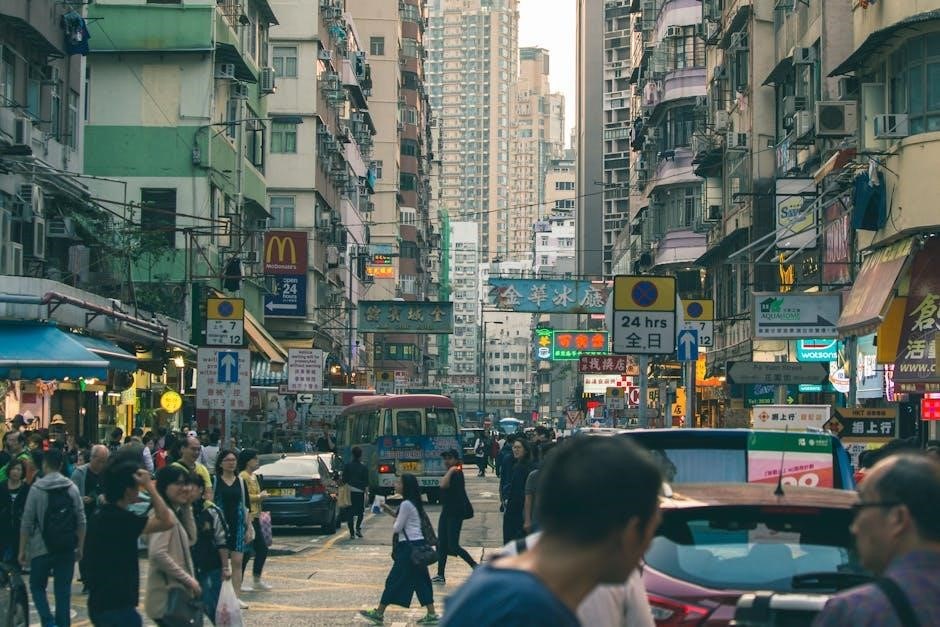Traffic Signs Manual Chapter 6 provides guidance on traffic control measures, focusing on effective road management and safety․ It covers traffic signals, pedestrian crossings, and temporary traffic arrangements to ensure safe and efficient movement of road users․
1․1 Overview of Chapter 6
Chapter 6 of the Traffic Signs Manual focuses on traffic control measures, providing detailed guidance on signs, signals, and road markings․ It aims to enhance road safety, improve traffic flow, and ensure compliance with legal requirements․ The chapter is designed for traffic authorities, contractors, and designers, offering practical advice on effective traffic management and maintaining road user safety․
1․2 Importance of Traffic Control
Traffic control is essential for maintaining road safety and efficiency․ It ensures smooth movement of vehicles and pedestrians, reduces congestion, and prevents accidents․ Clear signage and signals guide road users, enhancing mobility and reducing travel time․ Effective traffic control measures also support environmental goals by minimizing delays and optimizing traffic flow, benefiting both urban and rural areas․
1․3 Key Components Covered in Chapter 6
Chapter 6 focuses on traffic control, detailing principles for traffic signals, pedestrian crossings, and temporary traffic management․ It provides guidance on signal design, phasing, and timing, as well as safe infrastructure for pedestrians․ The chapter also addresses legal compliance, ensuring traffic measures align with regulations and maintain road user safety․ These components collectively aim to enhance traffic efficiency and safety in various urban and rural settings․
Traffic Signal Design and Operations
Traffic signal design ensures safety and efficiency, focusing on signal functionality, visibility, and timing․ Operations align with regulations, optimizing traffic flow and reducing congestion through precise engineering principles․
2․1 Principles of Traffic Signal Control
Traffic signal control principles focus on optimizing traffic flow, reducing congestion, and enhancing safety․ Signals are designed to be visible and standardized, ensuring clarity for drivers, pedestrians, and cyclists․ The system prioritizes smooth movement, minimizing delays while adapting to varying traffic conditions․ Signals are strategically timed and coordinated to maintain efficient traffic management, ensuring safety and accessibility for all road users․
2․2 Design Considerations for Traffic Signals
Designing traffic signals involves ensuring visibility, clarity, and consistency․ Signals must be positioned to avoid obstructions and maintain clear sightlines for drivers and pedestrians․ Standardized colors, shapes, and timings are crucial for universal understanding․ The design must also accommodate varying traffic volumes and speeds, while adhering to accessibility standards for all road users, including those with disabilities․ Compliance with traffic regulations ensures safety and efficiency in signal operation․
2․3 Signal Phasing and Timing
Signal phasing and timing are critical for efficient traffic flow and safety․ Phasing involves sequencing signal stages to prioritize movements, while timing ensures durations align with traffic demand․ Coordinating signals across intersections enhances overall network performance․ Pedestrian phases must be adequately timed to allow safe crossing․ Dynamic adjustments based on real-time traffic data optimize signal operation, minimizing congestion and reducing delays for all road users․

Pedestrian Crossings and Safety
Pedestrian crossings ensure safe road user interaction, with clear markings and signals․ Design focuses on visibility, accessibility, and traffic flow management to enhance safety for all pedestrians․
3․1 Types of Pedestrian Crossings
Pedestrian crossings include zebra, pelican, and puffin crossings, each designed to ensure safe road user interaction․ Zebra crossings feature black and white stripes, while pelican and puffin crossings incorporate traffic signals․ These designs enhance visibility, accessibility, and safety, with clear markings and signals guiding pedestrians and drivers․ Their placement and design prioritize efficient traffic flow and pedestrian protection, adhering to safety standards outlined in the manual․
3․2 Designing Safe Pedestrian Infrastructure
Designing safe pedestrian infrastructure involves ensuring visibility, accessibility, and clear communication․ Key elements include adequate lighting, visible road markings, and accessible pathways․ The placement of crossings, signage, and signals must align with pedestrian behavior and traffic flow․ Clear visibility for drivers and pedestrians is crucial, as is the integration of traffic signals to manage movement effectively while minimizing conflicts between road users․
3․3 Managing Pedestrian Traffic Flow
Managing pedestrian traffic flow involves coordinating signals, signage, and infrastructure to ensure safe and efficient movement․ Clear signage and visible markings guide pedestrians, while traffic signals prioritize crossings․ Real-time monitoring and adaptive signal control optimize flow during peak times․ Ensuring accessibility and visibility for all users is critical, balancing pedestrian and vehicular needs to maintain smooth traffic operations and enhance overall safety․

Temporary Traffic Management
Temporary traffic management ensures safety and efficiency during roadworks or events․ It involves planning, signage, barriers, and safety measures to guide drivers and pedestrians effectively․
4․1 Planning Temporary Traffic Arrangements
Planning temporary traffic arrangements involves assessing site conditions, traffic flow, and safety risks․ It includes selecting appropriate signs, barriers, and diversions to maintain order and visibility․ Compliance with safety standards ensures minimal disruption and protects road users during construction or events․
4;2 Use of Temporary Traffic Signs and Barriers
Temporary traffic signs and barriers are essential for maintaining safety during roadworks or events․ Warning signs, diversion signs, and informational signs guide drivers through changes․ Barriers physically control access and protect work zones․ Proper placement and visibility ensure compliance with safety standards, minimizing disruptions and reducing accident risks․
4․3 Safety Measures for Temporary Traffic Control
Safety measures for temporary traffic control ensure minimal risks to road users and workers․ Proper placement of signs and barriers, clear visibility, and compliance with standards are crucial․ Illumination at night and use of cones or barricades enhance safety․ Workers must wear high-visibility clothing․ Regular inspections and emergency response plans further mitigate potential hazards, ensuring safe traffic flow during temporary arrangements․

Legal and Regulatory Requirements
Chapter 6 emphasizes compliance with Traffic Signs Regulations, outlining legal duties of traffic authorities to ensure safe and efficient road networks․ Enforcement measures guarantee adherence to these standards․
5․1 Compliance with Traffic Signs Regulations
Compliance with Traffic Signs Regulations is essential for ensuring road safety and legal adherence․ The manual provides detailed guidance on prescribed traffic signs, markings, and illuminations, applicable across England, Wales, and Scotland․ Proper compliance ensures consistency, clarity, and enforceability of traffic control measures, minimizing risks and enhancing overall road user safety while meeting legal responsibilities of traffic authorities․ Adherence is non-negotiable for effective traffic management․
5․2 Legal Responsibilities of Traffic Authorities
Traffic authorities must adhere to legal obligations in managing traffic control devices․ They are responsible for ensuring signs and markings comply with regulations, maintaining visibility, and addressing safety concerns․ Authorities must also consult stakeholders and conduct regular audits․ Non-compliance can result in legal actions, emphasizing the importance of fulfilling these duties to protect road users and uphold public safety standards effectively and consistently․ Legal responsibilities are crucial for accountability and trust in traffic management systems․
5․3 Enforcement of Traffic Control Measures
Enforcement of traffic control measures ensures compliance with regulations, enhancing road safety; Authorities use surveillance, penalties, and public awareness campaigns to enforce adherence to traffic signs and signals․ Legal measures, including fines and penalties, deter violations․ Effective enforcement maintains order, prevents accidents, and upholds the integrity of traffic management systems, ensuring the safety and efficiency of road networks for all users consistently and reliably․
Maintenance and Inspection of Traffic Control Devices
Regular maintenance ensures traffic control devices function correctly, while inspections identify repairs needed to maintain safety and efficiency on roads, adhering to established standards and procedures․
6․1 Regular Maintenance Practices
Regular maintenance of traffic control devices ensures optimal functionality and safety․ This includes periodic inspections, cleaning, and repairs to signs, signals, and road markings․ Authorities must address issues promptly to maintain visibility and durability, ensuring compliance with safety standards and regulations․ Proper scheduling and record-keeping are essential to track maintenance activities and prevent deterioration of traffic control infrastructure over time․
6․2 Inspection Frequency and Standards
Regular inspections of traffic control devices are crucial to ensure safety and compliance․ Authorities should conduct inspections at prescribed intervals, such as annually, to assess visibility, damage, and reflectivity․ Standards dictate that signs and signals must meet specific criteria for size, color, and placement․ Documentation of findings ensures accountability and timely addressing of deficiencies, maintaining road user safety and regulatory compliance effectively․
6․3 Repair and Replacement Procedures
Traffic control devices requiring repair or replacement must be assessed for damage or deterioration․ Repairs should prioritize safety, restoring visibility and functionality promptly․ Replacement is necessary when signs or signals are beyond repair or no longer meet standards․ Documentation of all actions ensures accountability and compliance with regulations, maintaining road safety and efficiency; Timely execution prevents hazards and ensures continued effective traffic management․

Future Developments in Traffic Control
Smart traffic systems, real-time data integration, and sustainable designs are reshaping traffic control․ These advancements aim to enhance safety, efficiency, and environmental compatibility for future road networks․
7․1 Emerging Technologies in Traffic Management
Emerging technologies like smart traffic signals, real-time data analytics, and IoT-enabled sensors are transforming traffic management․ These innovations optimize traffic flow, reduce congestion, and enhance safety․ AI-driven systems predict traffic patterns, while connected infrastructure improves responsiveness; Such advancements ensure efficient, sustainable, and adaptive traffic control solutions for modern urban challenges․
7․2 Sustainability in Traffic Control Design
Sustainability in traffic control design focuses on eco-friendly materials and energy-efficient technologies․ LED traffic signals and solar-powered systems reduce carbon footprints․ Design strategies prioritize longevity and minimal environmental impact, aligning with global sustainability goals․ This approach ensures traffic control measures are both effective and environmentally responsible, supporting long-term cost savings and reduced energy consumption for traffic authorities․
7․3 Adapting to Changing Traffic Patterns
Adapting to changing traffic patterns involves using real-time data and intelligent systems to optimize traffic flow․ Dynamic traffic signals and responsive signage adjust to current conditions, minimizing congestion․ This approach ensures traffic control measures remain effective amid population growth, urban development, and evolving driver behavior, promoting safer and more efficient road networks for future transportation needs․
